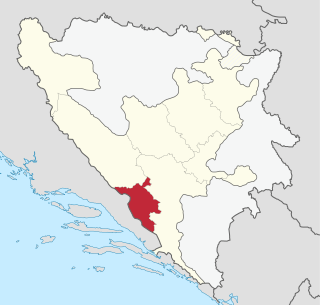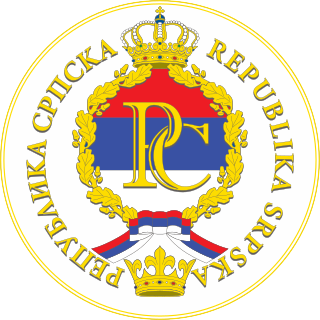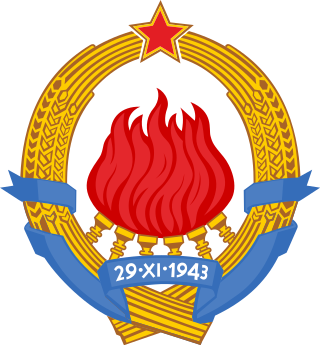
The uses of heraldry in Bosnia and Herzegovina is used by government bodies, subdivisions of the national government, organizations, corporations and by families. [1]

The uses of heraldry in Bosnia and Herzegovina is used by government bodies, subdivisions of the national government, organizations, corporations and by families. [1]

A coat of arms is a heraldic visual design on an escutcheon, surcoat, or tabard. The coat of arms on an escutcheon forms the central element of the full heraldic achievement, which in its whole consists of a shield, supporters, a crest, and a motto. A coat of arms is traditionally unique to the armiger. The term itself of 'coat of arms' describing in modern times just the heraldic design, originates from the description of the entire medieval chainmail 'surcoat' garment used in combat or preparation for the latter.

The fleur-de-lis, also spelled fleur-de-lys, is a lily that is used as a decorative design or symbol.

The flag of Bosnia and Herzegovina contains a medium blue field with a yellow right triangle separating said field, and there are seven full five-pointed white stars and two half stars top and bottom along the hypotenuse of the triangle.

The coat of arms of Bosnia and Herzegovina was adopted in 1998, replacing the previous design that had been in use since 1992 when Bosnia and Herzegovina gained independence. It follows the design of the national flag. The three pointed shield is used to symbolize the three major ethnic groups of Bosnia, as well as allude to the shape of the country.

Canton 10 or Herzeg-Bosnian Canton is the largest of the cantons of the Federation of Bosnia and Herzegovina by area and eighth by population. The local government seat is in Livno, while the assembly is in Tomislavgrad.
There is currently no official flag for the Federation of Bosnia and Herzegovina. The federation is part of the state of Bosnia and Herzegovina. The federation adopted its own flag in 1996, but the flag and associated coat of arms were deemed unconstitutional by the Constitutional Court of Bosnia and Herzegovina in 2007. The federation has not yet adopted a new flag, anthem or coat of arms; instead the symbols of the central state are used for official purposes as a provisional solution.
This armorial of sovereign states shows the coat of arms, national emblem, or seal for every sovereign state. Although some countries do not have an official national emblem, unofficial emblems which are de facto used as national emblems are also shown below.

The West Herzegovina Canton is one of the cantons of the Federation of Bosnia and Herzegovina. The West Herzegovina Canton is in the Herzegovina region in the southwest of Bosnia and Herzegovina. Its seat of government is in Široki Brijeg, while other municipalities within the Canton are Grude, Ljubuški and Posušje. It has 94,898 inhabitants, of whom more than 98% are ethnic Croats.

The Serbian Cross is a national symbol of Serbia, part of the coat of arms and flag of Serbia, and of the Serbian Orthodox Church. It is based on the tetragrammic cross emblem/flag of the Byzantine Palaiologos dynasty, with the difference that in Serbian use the cross is usually white on a red background, rather than gold on a red background.
There is currently no official coat of arms for the Federation of Bosnia and Herzegovina. The federation is part of the state of Bosnia and Herzegovina.

The flag of Republika Srpska within Bosnia and Herzegovina was adopted on 24 November 1992. The flag is a rectangular tricolor with three equal horizontal bands of red, blue and white. It is almost identical to the civil flag of Serbia, but with different aspect ratio of 1:2 instead of 2:3 and slightly different color shades.The flag is the same used at the Misiones Province in Argentina.

Hungarian heraldry generally follows German heraldry in its artistic forms, but has its own distinctive character. It is classified to Central and Eastern European heraldry.

The Seal of Republika Srpska with the description: the flag of Republika Srpska and the Cyrillic letters "РС" ("RS"), the red-blue-white tricolor are in the center of the seal, twisted with the golden Oak leaves, a traditional pre-Christian symbol sacred to most Slavs. On the edge of the seal there is an inscription Republika Srpska. The open crown of Kotromanić is shown in the bottom of the seal and the seal itself is topped with a heraldic royal crown.
Bosnia and Herzegovina vehicle registration plates have held their current form since 2 February 1998. Currently the Bosnia and Herzegovina (BiH) vehicle registration plate format consists of seven characters: five numbers and two letters arranged in the following order: X00-X-000. The plates are uniform across the country and do not denote the place where the vehicle is registered, as was the case prior to 1998. Likewise the plates do not contain any heraldic symbols. The plates use only letters which are represented equally in Latin and Cyrillic script.

Socialist-style emblems usually follow a unique style consisting of communist symbolism. Although commonly referred to as coats of arms, most are not actually traditional heraldic achievements. Many communist governments purposely diverged from heraldic tradition in order to distance themselves from the monarchies that they usually replaced, with coats of arms being seen as symbols of the monarchs.

The Macedonian lion is an unofficial symbol of North Macedonia. After the independence of the Republic of Macedonia from Yugoslavia, the lion was proposed as a coat of arms of the new independent state several times.

The national emblem of North Macedonia depicts two curved garlands of sheaves of wheat, tobacco leaves and opium poppy fruits, tied by a ribbon decorated with embroidery of traditional Macedonian folk motifs. In the center of the ovoid frame are depicted a mountain, a lake and a sunrise. The features of the national coat of arms contain a rising sun which symbolizes freedom, the Šar Mountains with its peak named Ljuboten or Mount Korab and the river Vardar, with Lake Ohrid. The emblem also contains opium poppy fruits; this poppy was brought to the area during Ottoman times in the first half of the 19th century. Until 16 November 2009, the emblem also depicted a socialistic five-pointed star in the top. The national parliament adopted the proposal to remove this element with 80 votes in favor and 18 against. This emblem had been in use since 1946, shortly after the republic became part of Yugoslavia.

The emblem of Yugoslavia featured six torches, surrounded by wheat with a red star at its top, and burning together in one flame; this represented the brotherhood and unity of the six federal republics forming Yugoslavia: Bosnia and Herzegovina, Croatia, Macedonia, Montenegro, Serbia and Slovenia. The date imprinted was 29 November 1943, the day the Anti-Fascist Council for the National Liberation of Yugoslavia (AVNOJ) met in Jajce on its second meeting and formed the basis for post-war organisation of the country, establishing a federal republic. This day was celebrated as Republic Day after the establishment of the republic. The emblem of Yugoslavia, along with those of its constituent republics, are an example of socialist heraldry.
Orders, decorations, and medals of Bosnia and Herzegovina are social and public recognitions, which are awarded for special contributions to the realization of human rights and freedom, for construction of democratic relations, peace and stabilization, development of International cooperation of Bosnia and Herzegovina with other countries and with International organizations and for cultural, economic and every other progress of people and citizens of Bosnia and Herzegovina. The system of honours of Bosnia and Herzegovina was established after the Croat–Bosniak War ended in 1994, and changed in May 2003.

Fojnica Armorial is a prominent Illyrian armorial which contains South Slavic heraldic symbols, and expresses romantic nationalism and Illyrism rather than historical accuracy. The manuscript is named after the Franciscan monastery in Fojnica where it was kept.